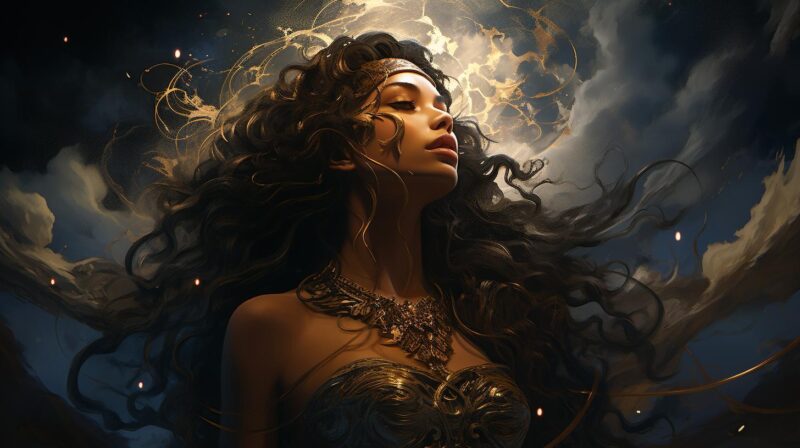Mayari is a figure from Philippine mythology, known for her role as the moon goddess and a fierce warrior. Despite losing an eye in a battle with her brother, she continues to rule the night with determination.
Her story reflects resilience and strength, showing that even in the face of adversity, one can rise and shine.
In this article, we will explore the mythology surrounding Mayari, her origins, her role in the pantheon, and the lessons her story imparts.
The Origins of Mayari
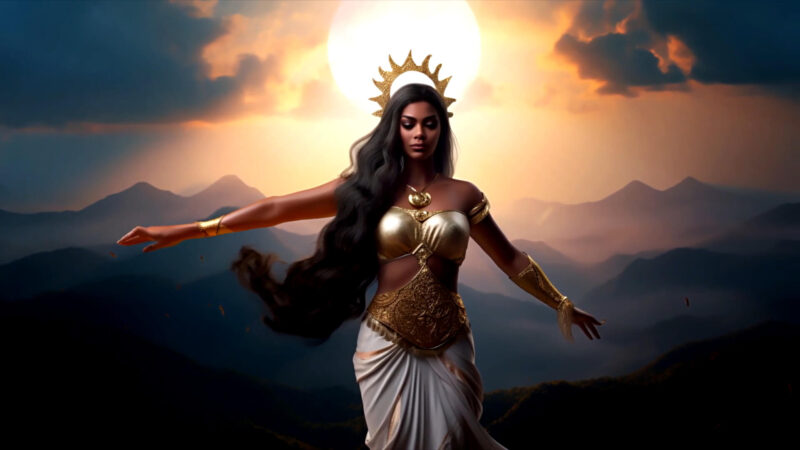
She is the daughter of Bathala, the supreme god in Tagalog mythology, and a mortal woman. Alongside her sisters, Tala (goddess of the stars) and Hanan (goddess of the morning), Mayari forms part of a powerful celestial family that holds dominion over various aspects of the natural world.
In some variations of her myth, Mayari is also considered to be the most beautiful deity in Bathala’s court, known not only for her physical appearance but also for her strength and warrior attributes.
Despite her beauty, Mayari is deeply connected to themes of war, revolution, and strength. Her origins are tied to the idea of duality, balancing her role as a nurturing figure with her identity as a fierce protector.
One of the most famous stories involving Mayari is her battle with her brother Apolaki, the god of the sun. This conflict arose after the death of their father, Bathala, when the two siblings quarreled over who would rule the earth
. The battle, fought with bamboo clubs, ended with Mayari losing an eye. Despite this injury, she remained strong, and Apolaki, feeling remorseful, agreed to share dominion with her. Thus, Apolaki ruled the day, while Mayari ruled the night, her dimmed light reflecting the injury she sustained during their battle.
The worship of Mayari has historical roots in various rituals and traditions that honored her as the goddess of the moon. These practices often involved offerings and prayers during specific lunar phases, particularly during the new and full moons.
The Battle with Apolaki
Mayari is also a fierce warrior who isn’t afraid to go head-to-head with her brother, Apolaki, the god of the sun. This battle between siblings isn’t just a simple family quarrel; it’s a significant myth in Filipino culture that explains how day and night came to be.
The Fight for the Earth

After the death of their father, Bathala, there was no clear succession plan. Mayari and Apolaki both wanted to rule the earth.
Apolaki, known for his fiery nature, wanted sole control, while Mayari, true to her sense of balance, insisted on ruling together. They eventually clashed in a brutal battle using bamboo clubs.
This fight was intense and ended with Mayari losing one of her eyes, which is why the moon’s light is dimmer compared to the sun.
Despite being injured, Mayari didn’t back down. Apolaki, realizing the damage he had done, felt remorse and agreed to share the rule of the earth.
Apolaki would rule the day, and Mayari would rule the night. This compromise brought balance to the world, with Mayari’s soft glow guiding people through the darkness.
The Symbolism of Their Conflict
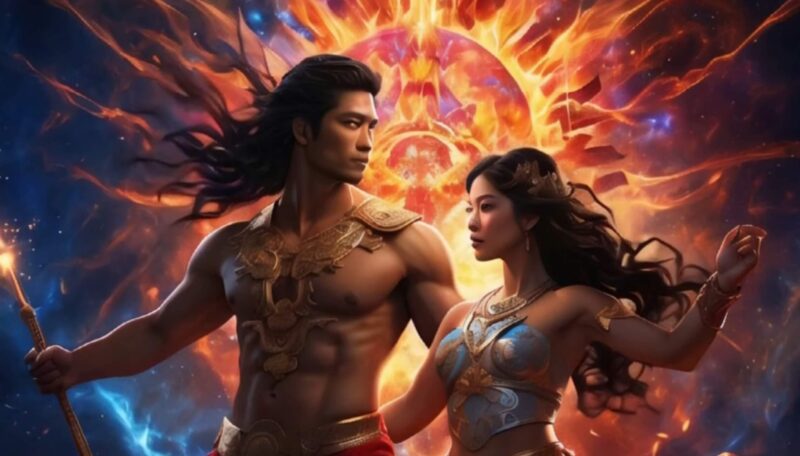
The battle between Mayari and Apolaki is more than just a myth; it’s a representation of the balance between light and darkness, day and night.
Mayari’s injury symbolizes the sacrifices that come with leadership and the importance of compromise. The fact that she continues to shine despite losing an eye shows her resilience and strength.
Mayari’s role as the moon goddess also ties her to the cycles of life, reflecting how light and darkness are both essential parts of existence.
The compromise between her and Apolaki emphasizes the need for cooperation and balance in the world.
Mayari as the Moon Goddess
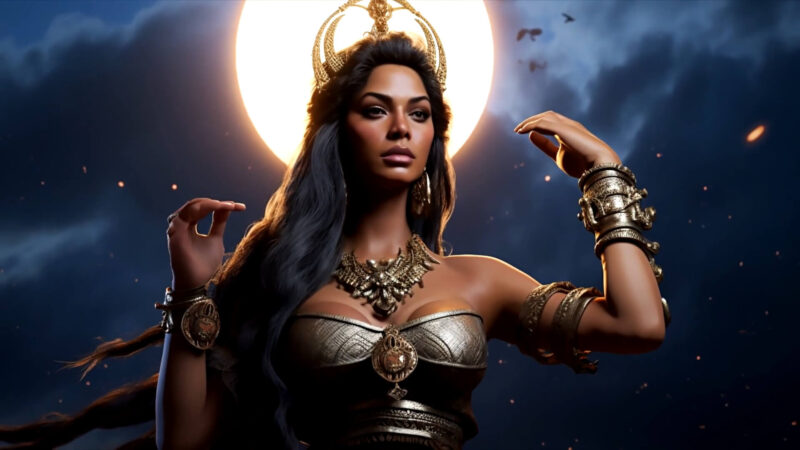
Mayari is the moon goddess in Philippine mythology. She rules over the night, offering light and guidance when the sun is gone. After losing an eye in a battle with her brother, Apolaki, her light became softer, but she still shines through the darkness. Her story is about strength and resilience.
The Moon in Filipino Culture
The moon is important in Filipino culture. It affects the tides, agriculture, and the rhythms of daily life. Mayari’s influence is felt in these natural cycles. She is seen as a protector, ensuring safety for those who need to venture out at night.
Her light is a symbol of hope and guidance, especially during tough times.Filipiness
Rituals and Traditions Filipiness
Filipinos honor Mayari with specific rituals, especially during the new moon and full moon. They offer prayers and gifts, asking for her blessings.
During the full moon, there’s a tradition where suitors present flowers to their beloved, seeking Mayari’s favor.
Warrior Attributes
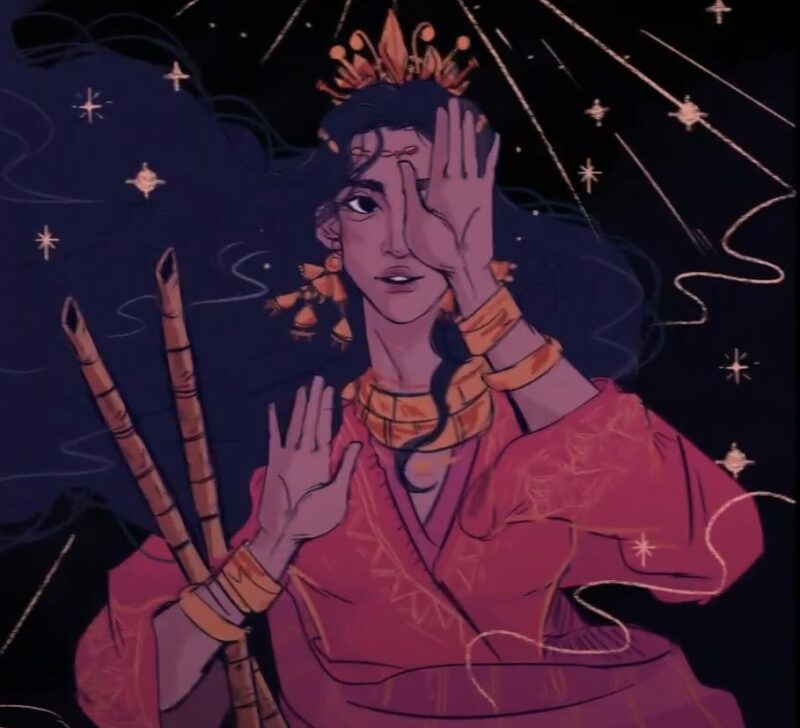
Mayari stands out not only as the goddess of the moon but also as a fierce warrior in Philippine mythology. Known for her strength and resilience, she symbolizes the duality of compassion and power.
Weapons and Fighting Style
Mayari is often depicted with traditional Filipino weapons. She wields a baston and yantok, sticks used in Eskrima, Arnis, or Kali. The baston is shorter, about 24 to 28 inches, while the yantok ranges from 28 to 36 inches.
These weapons are integral to Filipino martial arts, which emphasize quick, powerful strikes and fluid movements.
Strength and Resilience
Mayari’s story is one of perseverance. Despite losing an eye in battle, she continues to lead and protect. Her injury doesn’t diminish her strength but instead highlights her resilience.
She remains a formidable figure, symbolizing the strength needed to face and overcome adversity.
Cultural Significance
Mayari holds a special place in Philippine culture and mythology. As the goddess of the moon and a fierce warrior, she represents more than just celestial power. Her influence extends to various aspects of life, embodying the values and beliefs deeply rooted in Filipino traditions.
Role in Filipino Traditions
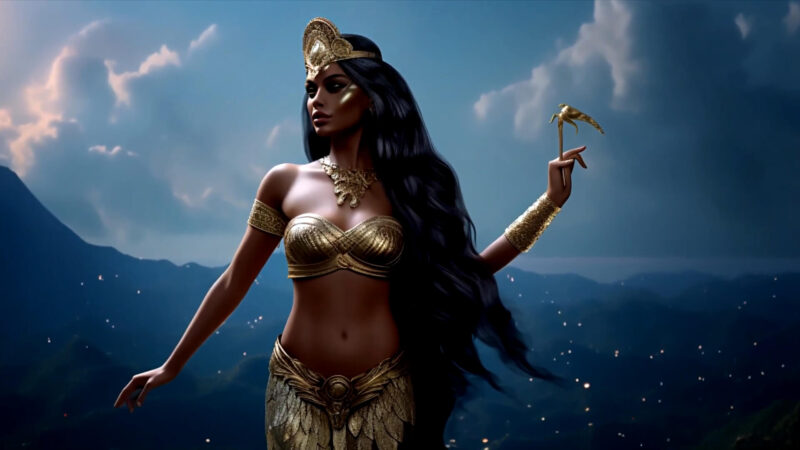
In ancient Filipino society, Mayari was honored in various rituals, particularly during significant lunar phases. People offered prayers and gifts to seek her blessings, especially during the new moon and full moon.
These offerings often included food, flowers, and other valuables, symbolizing a request for protection and prosperity.
For example, during the full moon, suitors would present sampaguita flowers to their beloved, a practice known as the Cortejo de Mayari.
Mayari’s influence was also felt in the protection of travelers and those who worked under the cover of night. Sailors, hunters, and others who ventured out after dark often prayed to her for safety.
This connection to night-time activities made her an essential deity for those relying on the moon’s light.
Symbol of Strength and Resilience
Mayari’s story, particularly her battle with Apolaki, serves as a powerful symbol of resilience. Despite losing an eye, she continued to fulfill her duties as the moon goddess, guiding people through the night.
This aspect of her story has made her a symbol of inner strength and perseverance, qualities that are highly valued in Filipino culture.
Her dual role as both a nurturing goddess and a fierce warrior also highlights the balance between compassion and strength. This balance is reflected in various aspects of Filipino life, from the importance of family and community to the values of courage and determination in the face of adversity.
How Mayari Is Viewed Today
Today, Mayari remains an important figure in Filipino culture. Her story and symbolism continue to inspire people, especially when it comes to themes of strength and resilience.
Mayari is often celebrated in various forms of art, literature, and cultural events that honor the moon. She’s seen as a symbol of empowerment, particularly for women, and her legacy is kept alive through these modern interpretations and celebrations.
Modern Influence of Mayari
Mayari’s influence hasn’t faded with time. Instead, her story and symbolism continue to resonate in modern Filipino culture.
Her legacy is seen in various cultural practices, artistic expressions, and discussions about empowerment and resilience.
Influence in Contemporary Culture
In contemporary Filipino society, Mayari’s story is often referenced in art, literature, and cultural events. Her image as a strong and resilient goddess has made her a symbol of empowerment, particularly for women.
Modern interpretations of her myth highlight her strength, beauty, and the balance she represents between light and darkness. Artists and writers frequently draw inspiration from Mayari, creating works that reflect her dual nature as both a nurturing figure and a fierce warrior.
Representation in Art and Media
Mayari appears in various forms of media, from traditional visual art to modern digital representations. Her story has been adapted into different formats, including books, films, and online content, where she is often portrayed as a role model for strength and perseverance.
These representations help keep her story alive, allowing new generations to connect with her myth.
Cultural Events and Festivals
Mayari’s legacy is also celebrated in festivals and cultural events that honor the moon and its significance in Filipino culture. During these events, people reflect on her story, drawing lessons of resilience and strength.
These celebrations serve as a way to pass down her story and ensure that her influence continues to be felt in modern times.
FAQs
What does Mayari’s name mean?
Mayari’s name is believed to be derived from the Filipino word “yari,” which means “made” or “crafted.” This reflects her role as a creator and a powerful figure in mythology.
It symbolizes her ability to craft and influence the world around her, particularly through her connection to the moon and the night.
Is there any connection between Mayari and other moon goddesses?
Yes, Mayari shares similarities with other moon goddesses from different cultures, such as the Greek goddess Artemis and the Chinese goddess Chang’e.
However, Mayari’s story is unique to Filipino mythology, particularly her role as a warrior and the symbolism of her lost eye, which distinguishes her from other lunar deities.
How is Mayari honored in modern-day rituals?
In modern times, while there aren’t specific widespread rituals solely for Mayari, she is often honored during lunar festivals and cultural celebrations that focus on the moon.
People might offer prayers or participate in moon-viewing events that reflect her influence as a guardian of the night.
Are there any specific regions in the Philippines where Mayari is more prominently worshiped?
Mayari is most commonly associated with the Tagalog and Pampangan regions of the Philippines. In these areas, her myth has been more deeply integrated into local traditions and stories, particularly in relation to the balance of day and night.
Does Mayari have any offspring or descendants in mythology?
In some variations of the myth, Mayari is said to have a daughter, Tala, who is the goddess of the stars. This connection emphasizes the continuity of celestial power within her family, further linking the moon and the stars in Filipino mythology.
How has Mayari influenced Filipino martial arts?
Mayari’s warrior attributes and the weapons she is depicted with, such as the baston and yantok, have a connection to Filipino martial arts like Eskrima and Arnis.
These martial arts forms emphasize the use of sticks, reflecting the traditional weaponry associated with Mayari in her role as a protector and warrior.
Conclusion
Mayari, the moon goddess of Philippine mythology, is a powerful figure who embodies both strength and resilience. Her story is one of balance, where light and darkness coexist, and where beauty and power go hand in hand.
From her battle with Apolaki to her role as a protector during the night, Mayari’s influence extends beyond ancient tales and continues to inspire modern-day Filipinos.

